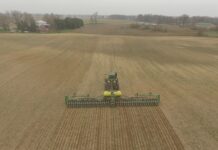We who live in Northeastern Ohio are extremely fortunate to have any plants growing in this region at all, not to mention the abundance of lovely native plant species that exist here.
The glaciations that covered this land for millions of years completely wiped out all but the tiniest cells of vegetation. The green plants could not survive, just as the dinosaurs could not survive “The Great Extinction.”
In the past, our local native plant species behaved very much like our predecessors, the native peoples who lived here and the immigrants who came later, in that they were all pioneers who came to inhabit a new land. These plants are young in years, compared with their counterparts who have lived in the same places for millions of years. Here is one chapter in the history of their travels, with a focus on the geology that influenced the native plants’ arrival here.
The glaciers
The last glacier left this land, which geologists refer to as the “Glaciated Allegany Plateau,” at the end of the “Wisconsinan Glaciation” about 14,000 years ago. The Wisconsinan was the last of three great glacial periods that spanned more than 300,000 years.
Summit County, located at approximately 41.1300 North latitude and -81.5300 degrees West longitude, is located in the Physiographic Region called the “Killbuck-Glaciated Pittsburgh Plateau.” This previously glaciated plateau area is characterized by steep ridges and uplands, greater than 1,200 feet in elevation, covered with thin glacial material, 51-80 feet of glacial drift and deep ravines and valleys at an elevation of 600 feet, holding as much as 21-260 feet of glacial drift. There are areas of moderate relief in between, at about 200 feet above sea level, (i.e. Lake Erie being the reference point.) Prominent landscape features here include ridge and ground moraines.
The geology
The Hudson area is also adjacent to the “Akron Canton Interlobate Plateau,” extending into Portage and Geauga counties, among others, whose features also include kames, eskers, kettle-hole lakes, bogs and fens. Herrick Fen, Triangle Lake Bog and Kent Bog, are all located in Portage Country. These natural areas are home to a diversified abundance of native plant species, including rare types such as the carnivorous “Pitcher Plant,” Sarracenia purpurea. Hudson is situated just on the boundary between the rock outcrops of two Geologic Systems.
To the east is the Pennsylvanian, with bedrock approximately 286-320 million years old, consisting of shale, sandstone, coal, clay and limestone. A prominent geological formation of this period is the Sharon Conglomerate. This rock is formed from small quartz pebbles rubbed round by continual tumbling in the fast-moving primeval streams of the Pennsylvanian period.
This pebbly sandstone resisted weathering by wind, water and the cycles of freezing and thawing, but the less resistant rock layers beneath eroded away, crumbling the base of support for the massive Sharon Conglomerate layer. It fractured in huge chunks, forming cliffs and ledges on the hillside and leaving huge jumbled slump blocks at the base of the cliffs. Some outstanding examples of Sharon Conglomerate can be viewed at Campbell’s Cave in Akron’s Gorge Park in the Summit Metro Parks system and at Nelson’s Ledges in Geauga County.
To the west is the Mississippian, with bedrock approximately 320-360 million years old, consisting of shale, sandstone and limestone, with Berea sandstone being a primary component. The Cuyahoga Valley National Park area is a showcase for a multitude of amazing bedrock displays, including the beautiful Brandywine Falls area, which also includes the community of Hudson, among others.
The soils
Now is the time to talk about the soils in this area, since all plants need a substrate on which to grow. All soils are composed of broken-up underlying bedrock, and organic mineral deposits. The rock residue in our northeastern Ohio soils comes mostly from glacial deposits dumped here during the last ice age. Soils formed on glacial debris benefit from a mix of rock types carried down by the glacier from Canada and the great Canadian Shield Range and tend to be more fertile than pure residual soils. But “rock alone does not a soil make,” so it is the addition of organics that really gives soil its fertility.
When you see a black soil, chances are good that plants once grew in a wetland in that area. The water prevented complete decay of the dead plant material that fell into it, allowing dark organic matter to build up. This is how bogs were formed in the kettle-holes left when parts of the frozen glacier melted in depressions. When the organics build up, and there is no incoming source of fresh water other than rain, you end up with an acidic peat bog like Triangle Lake. You can actually feel the spongy mat, which could be tens of feet thick, depress and bounce back as you apply pressure. Triangle Lake is home to many native plant families such as the Ericaceae family, which includes cranberries and blueberries. These plants have evolved here over thousands of years and thrive in bog conditions.
Like bogs, fens are peat lands, but have an incoming source of fresh water in addition to rain. Fens receive nutrients, usually through the groundwater, from upslope mineral soils, and are more alkaline than bogs. Fens can support a more diverse plant and animal community. Fens are home to plants like the Showy ladyslipper, Cypripedium reginae and many rushes and sedges.
Our native plants came to us thousands of years ago in various ways. Some seeds were carried by wind and water. Others were carried as nuts and seeds, digested and released by birds and animals. Some gradually crept up from our southern regions, each year gaining a few inches of ground to grow on. Some were carried sticking to the feathers, fur, scales, and fins, of our fellow creatures. Our wonderful pollinators, bats, birds, bees, butterflies, moths and others carried the pollen far away. Later on, Native Americans carried and dispersed seeds in their travels. The record of all of these mechanisms of succession can be found preserved in century’s worth of muck.
So now that we have learned of the gradual development of our native vegetation, from ice-age tundra to dry prairie to woodland, let’s talk about some wonderful qualities and advantages of native plants.
The plants
Native plants are beautiful and look wonderful in rain gardens, prairie gardens and everyday plantings. These plants add aesthetic and property value to any setting. But did you know that they also have the huge economic advantage of flood prevention, which also adds to your safety and property value?
The rain garden provides a depression which stores water, prohibits flooding and allows the water to percolate slowly into the soil. The extremely long roots of the native plants are much longer than those of cultivated turf grasses, (as long as 15 feet in some cases,) have more surface area, and therefore can hold more water and filter out more pollutants through cation exchange.
These perennial plants are low maintenance and because they are used to our soils and climate, thrive with no fertilizer, thereby decreasing pollution in our sheet flow and storm water runoff. They do not require mowing, and this reduces carbon dioxide emissions and use of fuel. Native plants provide huge amounts of habitat including food, cover, and nesting and egg-laying areas, for mammals, birds, insects, reptiles, amphibians and many other creatures.
I hope that this information will help you to understand and appreciate our native plants and their ecological niche, as well as their role in helping to improve storm water quality, while at the same time, reducing storm water quantity.
For more information, contact Summit County Soil and Water Conservation District at 330-926-2452.
(Sandy Barbic is an outreach coordinator at Summit County Soil and Water Conservation District. She can be reached at sbarbic@summitoh.net.)












